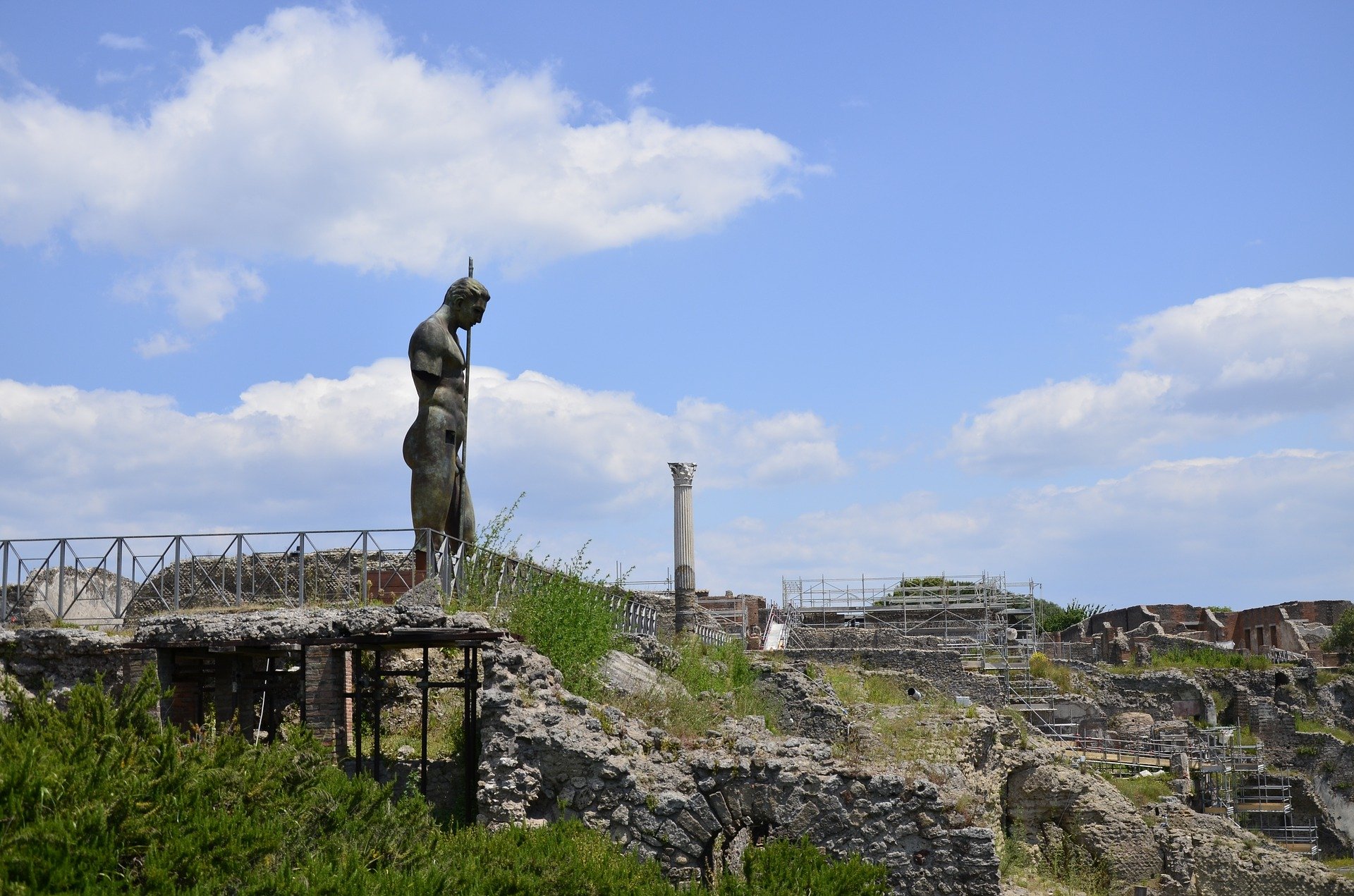The eruption of Mount Vesuvius lasted two days. The only witness to document his observations was Pliny the Younger, who recorded what he saw from Misenum, on the other end of the Bay of Naples. His uncle, Pliny the Elder, had ordered the ships under his command to sail to the Bay of Naples, close to Vesuvius. It is believed that it was at this point that Pliny the Elder and his men met their demise.
Though Pliny the Younger had not observed the circumstances under which his uncle had died, and there seems to be no mention of his having received an eye-witness account, he nevertheless went on to describe the demise of his uncle, Pliny the Elder, as follows:
“Then the flames and the smell of sulfur which gave warning of the approaching fire drove the others to take flight and roused him to stand up. He stood leaning on two slaves and then suddenly collapsed, I imagine because the dense fumes choked his breathing by blocking his windpipe, which was constitutionally weak and narrow and often inflamed. When daylight returned on the 26th – two days after the last day he had been seen – his body was found intact and uninjured, still fully clothed and looking more like sleep than death.”
The hazards of an erupting volcano are many and merciless as we shall see. It is difficult to imagine how a slow-moving flow of lava can present an imminent danger, especially one flowing at a leisurely pace down into the sea. But the very idea of lava coming in contact with the sea can be deceiving and tends to create a false sense of security. We have learned that molten lava coming in contact with the sea makes for a deadly hazard.
According to volcanologists, sea salt contains chloride which reacts with the hydrogen in the water to form hydrochloric acid. Molten lava coming in contact with the sea causes seawater to gush up into rising steam clouds of acid. Unwary sightseers observing such a sight, are likely to be at the mercy of any sudden-shifting wind-gusts which might blow the deadly clouds toward them.
As recently as the year 2000, two sightseers were reported to have been killed in just such a manner near Mount Kilauea, Hawaii. They were found dead with their lungs swollen and their skin eaten away by hydrochloric acid.
If Pliny the Elder ordered his ships to sail toward Mount Vesuvius in the Bay of Naples, it is quite possible that in an effort to save others, he and those around him were enveloped in gases which had gushed up into steaming clouds as the flaming lava flowed into the sea. This would probably have been prior to the first pyroclastic surge.
The bodies of many victims of the Mount Vesuvius eruption, discovered in various life-like poses, are helping scientists to rethink their previous interpretations of how many of these ancient Romans died. Until lately, it had been widely assumed that they had died of asphyxiation by volcanic ash and gas. However, recent studies indicate that most died of extreme heat, having been shocked into a kind of rigor mortis known as “cadaveric spasm.”
Volcanologist Dr. Giuseppe Mastrolorenzo, of the Italian Institute for Geophysics and Volcanology, and his colleagues began analyzing layers of buried volcanic ash and rock of Vesuvius. They then fed the data into a computer simulation of the Mount Vesuvius eruption. The results of their study indicated that the eruption produced six “pyroclastic surges.” However, it was the fourth surge which is believed to have killed people in a most peculiar way.
A pyroclastic surge consists of a dense, fast-moving ground-hugging wave of hot ash, lava, fragments and gases, ejected from the volcano with great explosive force. The gases can reach temperatures of about 1,830 degrees Fahrenheit. Pyroclastic surges travel downhill and spread laterally at speeds of up to 400 miles per hour.
About 75% of the known Pompeii victims were “frozen in suspended action” and show evidence of sudden muscle contractions. Dr. Mastrolorenzo contends that many of the first archeologists had misinterpreted the final moments of the victims, believing that they had died struggling as they breathed ash. Because of the extreme heat, “When the pyroclastic surge hit Pompeii, there was no time to suffocate,” said Dr. Mastrolorenzo. “The contorted postures are not the effects of a long agony, but the ‘cadaveric spasm’ of heat shock on corpses.”
Cadaveric spasm is a rare form of muscular stiffening that occurs at the moment of death and can be mistaken for rigor mortis. Cadaveric spasm may affect all muscles in the body but, typically, the hands. For example, a drowning victim in an effort to avoid drowning may clutch something at the moment of death, which provides evidence of a last life-saving struggle. Cadaveric spasm may show evidence of the last activity a person did just before death such as holding a knife tightly, commonly known as a “death grip.”
“During the pyroclastic surge, temperatures outdoors and indoors rose to 570 degrees Fahrenheit and more, enough to kill hundreds of people in a fraction of a second,” said Dr. Mastrolorenzo. “Heretofore archeologists misinterpreted them as people struggling to breathe and believed they died suffocated by ashes,” said Dr. Mastolorenzo. “Now we know that couldn’t be.”
The theories brought to light by Dr. Mastrolorenzo and his colleagues present probabilities previously unrealized, suggesting that the victims of the Mount Vesuvius eruption may have perished in ways still undiscovered.
Today, Mount Vesuvius is the only active volcano on the European mainland. It had a major eruption in the year 1631 and more recently in 1944. On that fateful August day in 79 AD, the people living below the volcano numbered approximately 12,000. Today, volcanologists tell us that we are due for another eruption in the near future. This one could be more devastating than the one in 79 AD since there are now 700,000 people who live in and around what has now been termed as the “death zone” of Mount Vesuvius. Why do they live there? As an example of the Neapolitan attitude toward the danger of eruption, one citizen was heard to remark, “We live day by day because Vesuvius could kill us at any moment.”
The studies are on-going and will no doubt continue for many years to come. If indeed a pyroclastic surge travels at a speed of 400 miles per hour, it is doubtful that anyone, in or near the death zone will outrun it.
































